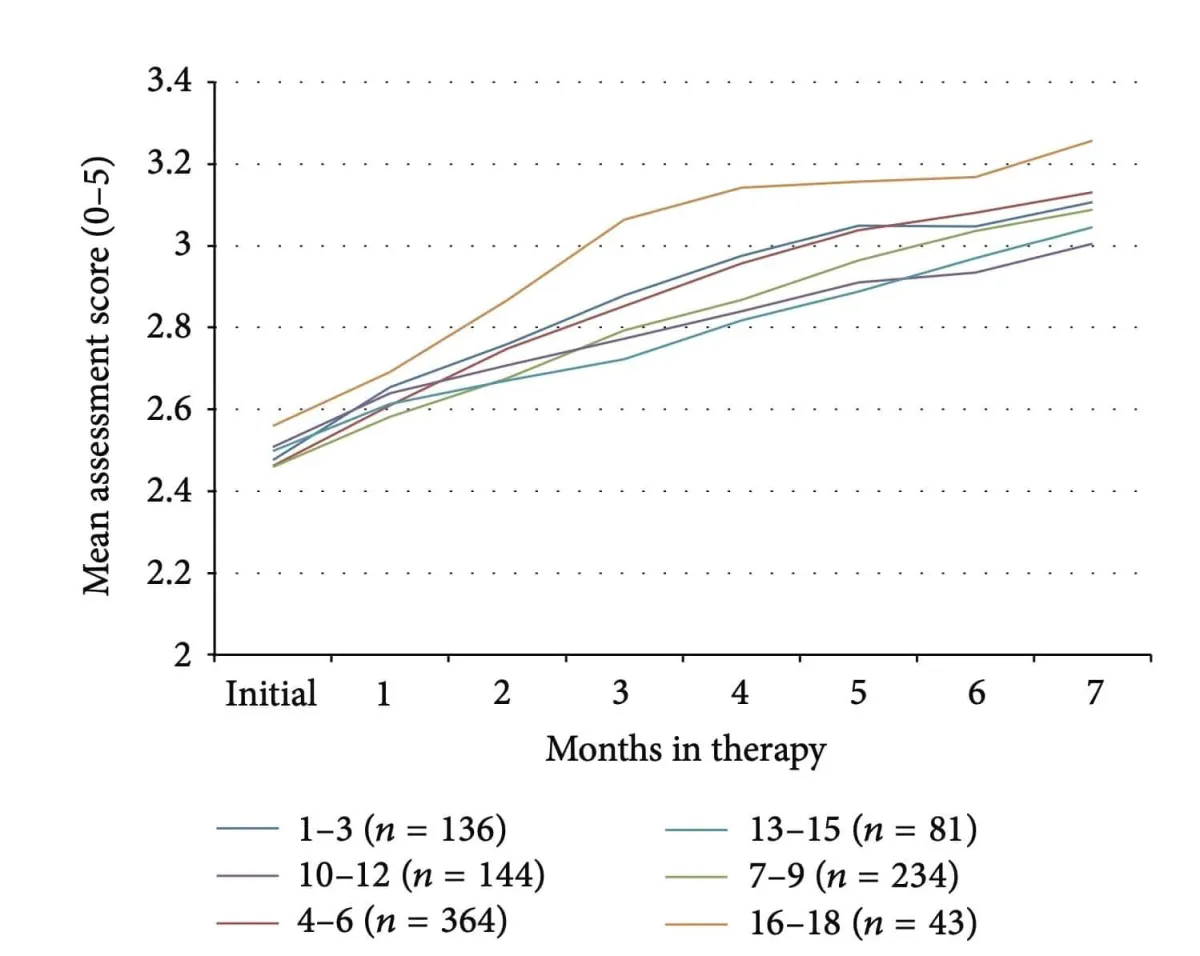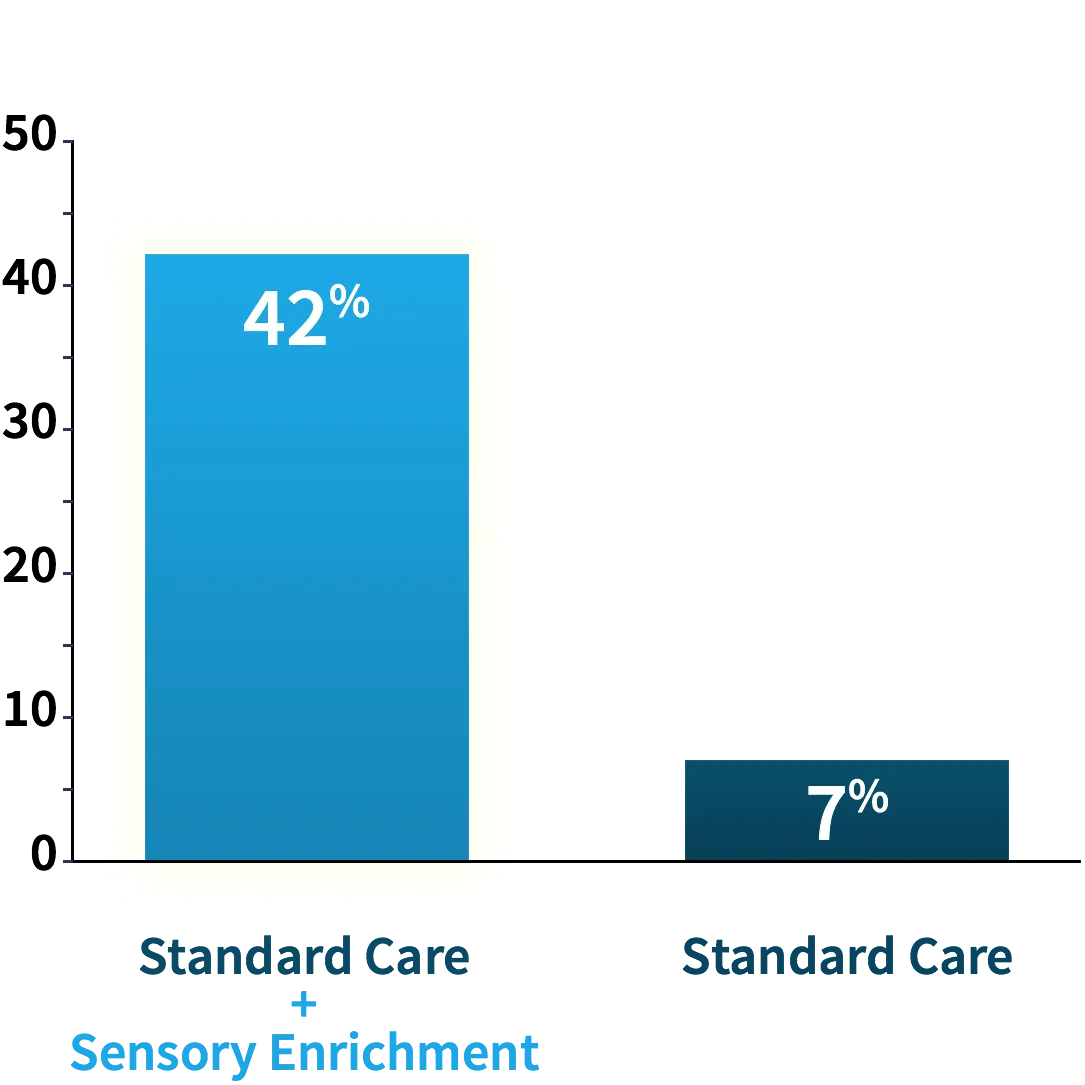Just screened for developmental delay, possibly autism?
Get ahead of the game by boosting brain development
Sensory Enrichment Therapy (S.E.T.) harnesses the science of Environmental Enrichment to induce an elevated state of neuroplasticity
Neuroplasticity is the ability of the brain to continue to change long after development is complete.
Environmental Enrichment is the field of neuroscience where they explore the impact of enriched experiences on brain development and brain function.
Sensory Enrichment Therapy is a translation of Environmental Enrichment protocols used in the lab for families to implement at home.
No waitlists!
By the time formal diagnosis and therapies are ready for them, your child could already be so much better!
With Mendability, in only 6 months your child's scores could already go from "Major Problem" to "Minor Problem".
Clinically Proven Therapy
In a study of 1,002 children who followed Mendability's S.E.T., they improved on average by 15% on a scale of 0 to 5.
*The scale goes from (0)Non-functional to (1)Severe Problem to (2)Major Problem to (3)Minor Problem to (4)Maybe a Problem to (5)Not a Problem.
In that study, the children had the following diagnosis:
• 590 autism
• 271 no formal diagnosis
• 41 Asperger’s
• 31 PDD
• 18 ADHD
• 10 global developmental delay
• 42 other diagnosis

Progress Rate by Age Group


Percentage of children who improved by 5 points or more on CARS after 6-month clinical trial
In randomized controlled trials conducted by the University of California, Irvine, children who added Sensory Enrichment therapy to their existing programs were 6X more likely to improve by 5 points or more on the Childhood Autism Rating Scale (CARS).

Percentage of children who moved up by one whole autism classification (ADOS-II) after 6-month clinical trial
Remarkably, 21% of the children in the Sensory Enrichment group moved up by one whole diagnostic classification on the Autism Diagnostic Observation Schedule (ADOS).
Woo, C. C., and Leon, M. (2013). Environmental enrichment as an effective treatment for autism: a randomized controlled trial. Behavioral Neuroscience. 127, 487–497.
Woo, C. C., Donnelly, J. H., Steinberg-Epstein, R., and Leon, M. (2015). Environmental enrichment as a therapy for autism: a clinical trial replication and extension. Behavioral Neuroscience. 129, 412–422.
Aronoff, E., Hillyer, R., and Leon, M. (2016). Environmental enrichment therapy for autism: outcomes with increased access. Neural Plast.
3,000+
Join 3,000+ other families who have also followed Mendability's Sensory Enrichment Therapy!
“This is really working! My toddler has started using functional language!
His cognition has improved, his motor skills are getting way better, he is finally starting to climb and point and wave and able to copy signs. He has been blossoming intensely, really catching up at a faster rate. Now we have SO much hope!”
– Melissa M. (New Zealand)
parent of a 3-year-old boy
“I think that [my son] is responding great to the therapy! He definitely seems to be following instructions better across the board and is just a little more aware of the world around him.
We have also seen some improvements in speech, pronunciation, eating, handwriting and overall function.”
– Sara J. (California)
parent of a 4-year-old boy
“I went to the library where we spent about 2 hours, and both of the girls were happily reading while staying in their seats. In our prior visits, the oldest one just roamed and ran around the library while I chased her. This time, I was pleasantly surprised by how long my oldest daughter (4) sat and stayed focus on reading. This has never happened before!”
– Mary M. (Texas)
parent of a 4-year-old-girl

The top 5 areas where parents report the most improvements in the first few weeks are Sleep, Eating, Social Skills, Attention and Sensory Processing
Tailored enrichment therapy is designed to boost brain plasticity in targeted brain functions
• Emotion (motivation to engage with other people),
• Self-awareness (where do I fit in space and this social world?),
• Fine motor (can I control my voice box, lips, breathing, etc.?),
• Auditory processing (can I hear myself speak?),
• Memory and learning (vocabulary, sentence structure),
• Mental image (can I picture what I want to say in my mind?), etc.
As these tools improve in the brain, the bottlenecks that slowed down natural speech development should fade away.
A couple of brain stimulation examples
Water Game
This exercise builds connections on the corpus callosum. It improves proprioception and improves communication between the two hemispheres of the brain.
Instructions
EQUIPMENT
– Two large bowls
– Warm Water
– Cold Water
PREPARATION
Fill two large bowls with water, one with cold tap water, and one with warm tap water. Place the two bowls in front of him at the table.
PROCEDURE
Assist your child into a seated position at the table, in front of the two large bowls.
They dip both hands into the bowls, one hand per bowl, down to the wrist line, without touching the sides or bottom of the bowls, for a second or two.
They remove their hands from the bowls, you switch them around and they dip their hands again.
The process repeats 2 more times, switching the bowls around each time.
The process goes, dip, un-dip, switch, dip, un-dip, switch, dip, un-dip, switch, dip, un-dip.
Smell and Touch Pairing
Scientists found remarkable changes in the brain when they were exposed to simultaneous olfactory (smell) and tactile (touch) stimulation, as opposed to olfactory or tactile stimulation alone.
More info
When you have a pleasant olfactory experience you get benefits in brain chemistry involved in better memory, mood, motivation, etc.
When you have a pleasant tactile experience like someone rubbing your back you get the benefits in brain chemistry involved in feeling calm, relaxed, for learning, for sensory integration, for movement, for sleep, for eating, etc.
When you combine these two experiences you get a third benefit associated with concentration, attention, cognitive function, and mood. It is also associated with higher states of plasticity when the brain is growing, adapting and rearranging its structure.
The effects above can last for over an hour!
Instructions
EQUIPMENT
– A fragrance (Essential oil, lotion, candle etc.)
PREPARATION
The fragrance can take almost any form so long as your child likes it.
PROCEDURE
While your child smells a pleasant fragrance, take your hand and stroke their back with your fingertips.
Feel free to vary speed, direction and pressure to suit your child's preferences.
This is how you will know it is working: Rowan will relax. Shoulders usually drop, with a sigh of relief, especially if he is 'high strung' to begin with.
Note: If the back is not the best spot to do it for your child then spend time exploring with this exercise until you find just the right spot to do this and just the right way that will make him relax within seconds.
It can't be ticklish. It can't be irritating. It should not be only barely tolerated, it should be pure pleasure and relaxation.
Your Mendability coach can help you find the best way to help your child benefit from this powerful sensory pairing.
Meet Claudie, the creator of Sensory Enrichment Therapy
More questions? More examples of games?
How about scheduling a call with a real person?
2011 - 2025 © Mendability - All Rights Reserved
